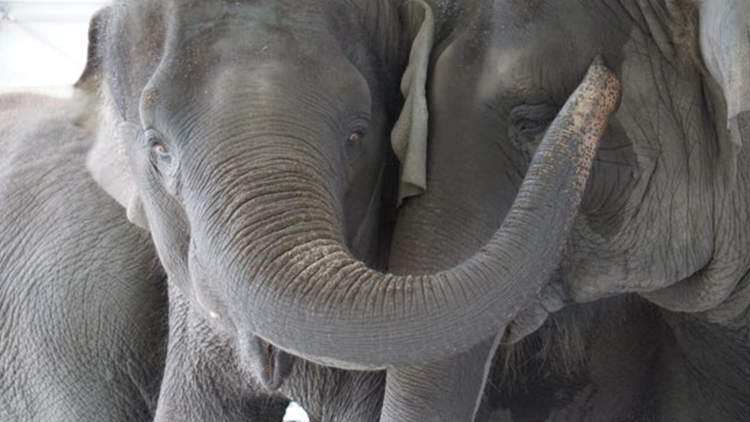They've worked hard all their lives. About 30 retired circus elephants — some slowed by age and infirmity — will live out the rest of their days in leisure at an internationally respected wildlife refuge in Northeast Florida.
White Oak Conservation is building a 2,500-acre habitat for the elephants in the heart of the nonprofit's 17,000-acre refuge on the banks of the St. Marys River in Yulee roughly 35 miles north of Jacksonville.
Most of the elephants previously traveled thousands of miles to perform throughout the United States with the Ringling Bros. and Barnum & Bailey circus until the animals were retired in 2016.
Since then, they have been living at the circus's Center for Elephant Conservation in Polk City — a small community in rural Central Florida.
The Ringling Bros. and Barnum & Bailey circus ended its 146-year run in May 2017, a year after retiring its elephants.
Feld Entertainment, the parent company of Ringling Bross, has provided food, care and expertise for the pending transition of the elephants to White Oak. Feld previously had come under fire in the past from animal welfare activists who accused the circus of animal abuse.
The first group of elephants is expected to arrive at White Oak — owned by philanthropists Mark and Kimbra Walter — early next year when the habitat is completed.
"Elephants are majestic and intelligent animals and they are in dire need," Kimbra Walter said. "For too long, humans have decimated the native habitats, poached and removed these animals from their natural home.”
The Walters have long been at the forefront of endangered wildlife and habitat conservation efforts throughout the United States and world.
“Our family is committed to improving the lives of individual elephants and ensuring the survival of elephants in the wild," Mark Walter said.
The soon-to-be new White Oak residents are all Asian elephants, said Michelle Gadd, who leads the Walters' global conservation efforts.
“Asian elephants are endangered in the wild. Only 30,000 to 50,000 elephants remain in the wild in less than 15 percent of their historic range," Gadd said. " Where they do survive, they continue to be threatened by habitat degradation and fragmentation, conflict with humans and poaching.”
At White Oak, the elephants will join about 30 wildlife species, including 17 that are endangered, such as Southern white rhinos, Florida panther, cheetahs, Grevy’s zebra, okapi, bongos and Florida grasshopper sparrow.
Gadd said the sprawling elephant habitat under construction is designed to provide enrichment and stimulation to the animals.
Construction began this month on the elephant complex. White Oak declined to reveal the project cost.
The habitat will encompass nine interlinked areas. The elephants will be able to roam, exercise and forage while exploring grasslands, forests and wetlands.
Essentially they will be free to be elephants — something circus life denied them.
The circus is the only life most of the elephants have ever known. It was days of boredom, traveling thousands of miles in cramped quarters, chained in place for hours and then performing in multiple shows.
The relative freedom of White Oak will take some getting used to for the animals. Some likely will be too timid — at least initially — to roam far from the elephant barn. Because most of the elephants never had to forage, the White Oak animal caretakers will be providing food as well as introducing them to foraging, Gadd said.
White Oak's philosophy "is to accommodate natural behavior and social bonds as closely as possible."
Family groups will be together, with calves and their mothers and siblings in the same areas as grandmothers wherever possible, said Gadd, explaining elephants have a distinct social order and close-knit bonds.
White Oak has recruited a team of elephant experts to design the habitat and care for the elephants. The team leader, Nick Newby, has managed elephants since 2003. He's a member of the Association of Zoos and Aquariums' Elephant Taxon Advisory Group, as well as an instructor in the Principles of Elephant Management program.
Gadd said the team has been evaluating and working with the elephants in preparation for their transition to White Oak. They're learning each animal's personality, preferences, pet peeves, and monitoring their health.
A total of 26 female and eight male elephants are eligible for the move to White Oak. The elephants range in age from an 8-year-old youngster up to a 63-year-old grande dame. Several others are in their 40s and 50s.
Among the elephants expected to come to White Oak are Kelly Ann, 24, Mable, 14, Luna, 36, Cora, 55, Osgood, also known as Ozzy, 21, and April, 10. Those animals have shown they can get along with each other.
"Our elephant whisperer Nick [Newby], who's in charge of the elephant program for us, has been spending his time getting to know these elephants and their social preferences, limitations and physical ailments for the past two years," Gadd said. "It's to see who tolerates each other, who really likes each other, who stays together and gets along well."
At least two elephants, she said, can't make the trip because of their age or physical disability. One is 74 years old and the other is blind. They probably will stay behind and keep each other company because the stress of the transition would be too much for them, Gadd said.
Such information will help White Oak make the final decision which elephants would fare the best in the move.
Plans show the habitat will have 11 waterholes and each will be built wide and deep enough for the elephants to splash and frolic in.
There will be three barns in the complex constructed specifically to meet the elephants' needs. Designed to be easily accessible to the elephants, those facilities will be equipped with high-tech veterinary equipment, according to the plans.
The project has garnered accolades in the conservation community.
"It is exciting to see these elephants transition into their new home while continuing their strong history as ambassadors for their wild cousins,” said Deborah Olson, executive director of the International Elephant Foundation. “White Oak's commitment to conservation and animal care makes it the perfect forever home for this herd."
The Association of Zoos and Aquariums, which sets standards for animal care and welfare, also has lauded the transfer.
"AZA strongly supports White Oak Conservation's efforts on behalf of elephants," said Dan Ashe, association president and chief executive officer. "By providing these elephants the space to explore, to interact with one another and to engage in natural behaviors, they are being given a key element in animal welfare and wellness — choice."
Gadd said the diversity of the elephant herd will contribute to the gene pool of Asian elephants in the United States. Some came to Ringling as working elephants in Asia and others were born here in the United States.
She said the elephants will be brought to White Oak in small groups over time.
"We are making this change extremely gradually … take it slow and we're going to get them there and let them go. Leave them undisturbed to just chill out and get used to their new world," Gadd said.
White Oak is a part of Walter Conservation, a unique center for conservation. It collaborates with state, federal, and international wildlife agencies and non-governmental conservation organizations.



